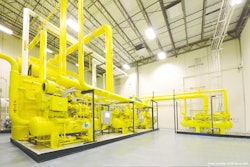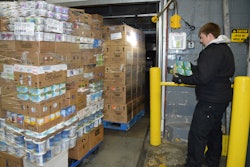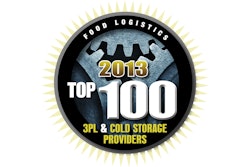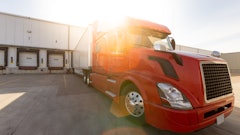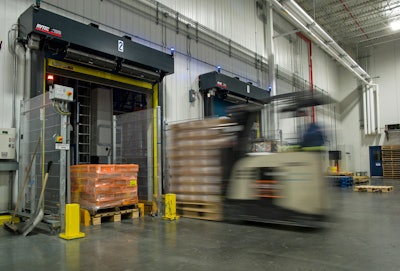
No segment of the food supply chain faces bigger challenges and opportunities than cold storage. Retailers and manufacturers of refrigerated and frozen food are finding new ways to meet customer needs more efficiently, thanks to improving software and automated material handling equipment.
Advanced engineering, automated materials handling equipment and RFID technology, in conjunction with WMS, is allowing retailers and 3PLs to improve temperature control and better manage refrigerated and frozen food.
High-speed doors improve efficiency
Preferred Refrigeration Services (PFS), a 3PL provider based in Elizabeth, N.J., recently achieved double digit growth after building facilities in strategic locations, continually investing and improving energy efficiency and optimizing refrigeration and automation design. High speed doors play a major role maintaining temperature and operating efficiently, notes Zan Perry, construction manager at PFS. A 10-million-cubic-foot facility in Elizabeth utilizes 12 insulated high-speed doors for entry into their automated, lights-out freezer.
The doors were engineered for our facility to be directly connected through a communication handshake to have the automation system open and close them on command and only as needed to be as efficient as possible.
The doors open and close per the WMS command, triggered by signals from the system. Special seals in the door’s side columns provide double seals on the front and back of the panel. Double brush seals combined with an idler barrel seal the top of the door. The vinyl loop creates a tight seal along the bottom of the door.
The roll-up door opens at peak speed of 101 inches per second average, reaching a peak speed of 182 inches per second. The speed enables the door to be open or closed in less than a second. The door impedes none of the motion of the conveyor system as it moves pallets in and out of the freezer.
This high speed also minimizes the amount of time the doorway is opened to prevent cold air loss between the minus 15-degree freezer and the 32-degree loading dock. Though the door is operating most of the time, when it isn’t, the door’s one-inch thick, closed-cell foam panel is laterally rigid to prevent bowing from air pressure and vertically flexible for fast speeds. The thermal panel is a non-porous, moisture-proof vapor barrier for uniform performance.
The facility is capable of taking in over 1,000 pallets per day, handling 2,000 SKUs.
The freezer area is fully automated, enabling precision order fulfillment with rapid product transfer.
The facility operates with less than 30 associates in a 30,000 square-foot dock area for receiving, palletizing, and shipping. The other 140,000 square-feet is within the storage freezer walls, in which a 72-foot-high automated storage and retrieval system manages all put-away operators.
Inside the freezer area, the racking has 25,000 eight-foot-tall pallet positions across 10 aisles. Five cranes roam these aisles to deliver pallets to and from the dock and a buffer area in the freezer.
Being a lights-out operation, the design not only saves labor, it also eliminates collateral heat from light bulbs and allows better temperature and humidity control.
Inside the freezer, a curve-going, rail-guided robotic stacker cranes handle goods in complete darkness as two pallets per minute move from the loading dock to the freezer’s high-speed Rytec door location.
The WMS communicates with each forklift by way of an onboard computer. Once the forklift driver picks up a pallet at the receiving door, the WMS receive notification. The system alerts the freezer crane that a load is on its way. By the time the forklift reaches the freezer doorway, the crane is ready for the pallet. The door quickly opens, enabling the crane to quickly pick up the pallet and retreat into the freezer, allowing the door to close in less than two seconds.
The system generates an energy efficient speed curve for smooth motion, soft starting and soft stopping. In the case of Preferred’s WMS, the system enables the door to interface with the operation for up-to-the-second deliveries at the freezer doorways.
As well as lowering energy costs, the panel’s heat transfer barrier prevents itself from becoming a condenser. This means moisture will not form on the panel surface and then drip on the floor. Wet floors or ice on floors are a slip hazard for personnel that can lead to injuries.
Poultry producer automates frozen warehouse
Myronivsky Hliboproduct (MHP), based in Kiev, Ukraine, the country’s largest poultry producer, recently built an automated frozen storage warehouse that would comply with the European requirements for an uninterrupted cooling chain, while offering a high level of energy efficiency and lower overall operating costs at the same time. In 2013, MHP exported about 25 percent of its poultry to the Commonwealth of Independent States (the former Soviet Republics), the Middle East, Central Asia and Africa. MHP consulted with Stuttgart, Germany-based viastore systems, an international intralogistics systems integrator, for support in developing its new storage warehouse.
MHP decided to build a new, state-of-the-art frozen storage warehouse at the Vinnytsia Poultry Complex in Ladyzhyn (about 185 miles Southwest of Kiev) in order to meet European standards. But other factors also played a role and were taken into account during the planning stage, according to Sergei Ivanov, director of engineering and planning at MHP.
“We were looking not only for an efficient solution with regard to a continuous cooling chain. The new warehouse also had to make optimum use of the available space and contribute to keeping manufacturing costs low,” he says.
MHP opted for a three-aisle automated storage and retrieval system (ASRS) warehouse with multi-deep storage to maximize the available space. “With cold and frozen storage, the higher the storage density, the better,” explains Frank Heptner, specialist in freezer warehouses at viastore. “ASRS solutions create very dense storage space that is particularly energy-efficient, with less space overall storage space required.”
While the rack height is limited to a maximum of 12 to 14 meters in manually operated storage systems due to the lift height of forklift trucks, automated high-bay systems can be much higher. MHP’s new, three-aisle frozen storage ASRS has an overall height of 20 meters and an area of 68 by 55 meters, with nine levels of storage space for a total of 20,300 pallets.
Servicing of the racks is done by three viapal storage/retrieval machines (SRMs). These machines are equipped with shuttles for multi-deep storage. Up to nine pallets can be stored one behind the other in each of the storage channels in a space-saving manner.
After processing, the chicken meat is initially shock-frozen and then packed into boxes and placed on pallets. These are positioned on the automatic conveyor system by forklift trucks and forwarded to the warehouse. There, one of the three SRMs takes over, and finally a shuttle transports the pallets with the goods from the SRM to the storage channel.
Retrieval and transport to the distribution center is similar – here the palletized goods are loaded onto trucks for shipment to the supermarkets. The WMS manages and controls the entire process automatically. “This has several advantages,” explains Heptner: “Every pallet can be identified and tracked at all times. In this way we can ensure that each product is at the right place at the right time – from goods receiving, storage and order picking all the way through to shipping.” The WMS monitors, for instance, the temperatures and expiration dates of the individual pallets to ensure consistently high product quality. If a pallet in the picking zone has remained unmoved for too long, it is automatically returned to the system before the cooling is interrupted.
In manually operated warehouses, errors occurred time and time again. Sometimes a product forgotten on the rack, sometimes the expiration date was not read correctly, or sometimes a pallet ended up in the wrong place. With the viastore WMS, such problems are a thing of the past, says Ivanov, director of engineering and planning at MHP. Another advantage is: “Since all the storage and transport processes take place fully automatically, no one has to work in the deep-freeze area. This makes their working conditions a great deal more pleasant.”
Hy-Vee utilizes RFID temperature tags
Hy-Vee, the West Des Moines, Ia.-based supermarket chain serving the Midwest states, recently implemented what it characterizes as a complete cold-chain management system to monitor temperature of perishable foods from the vendor to the distribution center and continuing to the store.
Hy-Vee, along with its technology provider, TempTRIP, installed RFID readers at its PDI distribution center in Ankeny, Ia. Hy-Vee now requires suppliers to include TempTRIP UHF Gen2 RFID temperature tags with every order. There is no infrastructure or hardware required by suppliers as they simply push and hold the button to start the tag.
The TempTRIP tags record time and temperature readings at pre-set intervals throughout the shipping and receiving process. When items arrive at the distribution centers, tags are passed by RFID readers placed between dock doors. The readers collect and send data to TempTRIP’s cloud-based cold-chain management system.
Algorithms are applied on a per-product basis, allowing each product to be evaluated based on specific temperature guidelines. Algorithms analyze the data and results are sent to a Hy-Vee website. Hy-Vee uses the data to refuse product, investigate product, measure performance, and provide feedback to drivers, carriers and suppliers, notes Kyle Oberender, Hy-Vee food safety director.
The data includes a complete record of the product’s temperature exposure during transport. The WMS allows Hy-Vee to set its own parameters for accepting product when it arrives.
“The temperature management capability is the biggest benefit to the system,” Oberender says. “We’re able to tie all temperature history directly to the equipment, the driver, as well as the supplier. The data integration is the key.”
The system gives Hy-Vee 100 percent cold chain monitoring and management capabilities both inbound and outbound, from multiple suppliers, subsidiaries, distribution centers, transport carriers, and retail store locations.
Product vendors order the tags from TempTRIP, notes Oberender.
Single-use temperature tags, in contrast, have to be manually retrieved from the delivery vehicle when it arrives and the dock and uploaded into a handheld computer to be reviewed and have its status determined. This typically takes five minutes per tag.
In addition to improving quality control, the tags, being battery powered, provide a sustainability benefit as well, Oberender says. The radio frequency temperature recorders that food suppliers usually use with are single-use tags. The TemPTRIP tags, by contrast, are reusable. “We don’t’ have to send them back. They are reconfigured.” He says Hy-Vee reuses about 1,000 tags per week.
The temperature control system is managed by Hy-Vee’s proprietary WMS, Oberender says.
The TempTRIP tags mark Hy-Vee’s most recent investment in warehouse automation, he adds. The company uses Vocollect voice picking and radio frequency, handheld scanners in its warehouse.
Monitoring food products during transit allows them to be confident in perishable product shelf-life, quality and safety, thus providing customers with a consistent product experience and ensuring customer loyalty.
“Hy-Vee is a pioneer in full cold-chain management in the retail space,” says Phaedra Culjak, chief operations officer of TempTRIP. “There are not any other retailers, that I am aware of, that have implemented such a complete, end-to-end temperature monitoring program that enables visibility and decision-making capabilities to reduce food waste, as well as increase the quality and safety of their products.”
PHOTO CAPTIONS
Pallet pickup
CAPTION:
The WMS system at Preferred Refrigeration Services coordinates pallet pickup to the instant at the freezer doorways.
Preferred Refrigeration
CAPTION:
When a pallet is ready for pickup, the WMS signals the forklift driver. Coordinating with the roll-up door, the system controls panel operation.
Speed of Doors
CAPTION:
The speed of the doors matches the speed of the operation at Preferred Freezer Services.
DSC_0603
CAPTION:
A team member in the Hy-Vee warehouse can see the temperature for a cold package after it was delivered to the warehouse.
Store Dock Temp Trip combined flat
CAPTION:
When items arrive at the Hy-Vee distribution centers, tags are passed by RFID readers placed between dock doors.






